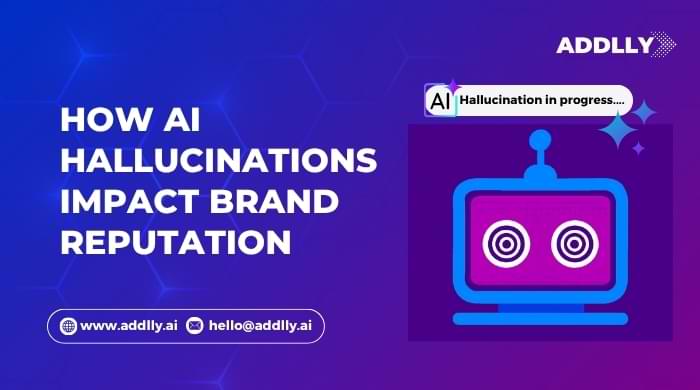Artificial intelligence (AI) has become an essential part of how businesses create, communicate, and connect. But as brands integrate AI systems into daily operations, a growing challenge has emerged – AI hallucinations.
Quick Summary – How AI Hallucinations Can Impact Your Brand Reputation
- AI hallucinations occur when artificial intelligence generates false or misleading information.
- These errors can cause brand reputation damage, customer dissatisfaction, and financial fallout.
- Main causes include poor data quality, limited human oversight, and biased training data.
- Effective solutions combine retrieval-augmented generation, knowledge graphs, and human review.
- Addlly AI integrates GEO and SEO audits, validation processes, and content tracking to help brands prevent hallucinations and maintain credibility.
- The right balance of AI technology and human judgment ensures factual accuracy, reliable communication, and long-term brand integrity.
What is AI Hallucination?
AI hallucination is when an AI model confidently generates false or fabricated information that appears convincing. These errors can include incorrect product details, fake citations, or misleading claims, all of which directly threaten brand credibility and customer trust. When AI systems produce inaccurate answers, it can quickly damage a brand’s reputation, especially if the misinformation spreads through customer-facing content or automated responses.
Generative AI models have accelerated content production, but they also increase the risk of inaccurate AI outputs. Understanding why hallucinations happen and how to address them is now critical for every business relying on AI-generated content to maintain its integrity and build lasting customer relationships.
Read about: Will GEO Replace Traditional SEO
What Causes AI Hallucination?
AI hallucinations usually stem from gaps in training data and the limitations of how large AI models interpret information. These systems learn from vast amounts of text, images, and data points, identifying patterns rather than verifying truth. When the data is incomplete or biased, an AI can produce a confident AI output that is entirely wrong.
Some of the most common causes include:
- Poor Data Quality: Inconsistent, outdated, or unverified data leads to inaccurate learning and increases the chance of false or misleading information.
- Biased Training Data: If an AI model is trained on biased sources, it may repeat or amplify those biases in its outputs.
- Over-reliance on Automation: Depending solely on AI tools without human oversight allows hallucinated content to pass unchecked.
- Lack of Validation or Fact-Checking: Without proper verification, AI-generated content may appear credible but contain incorrect or fabricated information.
- Limited Context Understanding: AI systems often miss nuances in language or cultural context, leading to confident but wrong interpretations.
Addressing AI hallucinations requires improving data quality, refining training processes, and embedding human review to double-check results before publication.
Human Error and AI
While AI hallucinations are often linked to technology, human error can also contribute to misinformation. Inadequate prompt design, vague instructions, or skipping review steps can all increase the risk of false information appearing in AI outputs.
But human advisors remain essential to identify these gaps. They interpret context, catch subtle inconsistencies, and apply ethical judgment that AI cannot replicate. By combining expert human oversight with advanced validation processes, businesses can minimize both AI and human-driven mistakes.
Types of False Information Which AI Models Can Generate
AI-generated errors can take many forms. Some are subtle, while others can cause serious reputational and financial damage. These issues can appear in customer-facing materials, promotional videos, and even decision-making processes supported by AI tools.
Common types of AI-generated errors include:
- Outdated or Inaccurate Data: AI may use old or irrelevant sources, leading to incorrect information being shared as current.
- Incorrect Product Details: Mismatched specifications, pricing errors, or false descriptions can mislead customers.
- Fake Citations: AI systems sometimes fabricate references or link to non-existent sources, reducing content credibility.
- Fabricated Research or Quotes: When AI generates data points or statements that were never published, it can spread misinformation.
- Misleading or Confident AI Output: Some AI-generated content appears authoritative but lacks factual information.
Brands must closely monitor AI outputs, do fact checking and verify truth before publishing to avoid catastrophic consequences.
Checkout our guide on: How to Run a GEO Audit
Impact of AI Hallucination on Business Operations
When AI hallucinations happen, the damage can extend beyond a single incident and the consequences are significant. Misleading information can result in customer dissatisfaction, financial fallout, and legal trouble. A single incorrect answer in an AI-generated chatbot response or social post can trigger reputational harm that takes months to rebuild.
Incorrect product details, misleading reviews, or fabricated insights can weaken customer relationships and diminish brand integrity. AI tools that are meant to improve efficiency can instead create confusion and distrust if left unsupervised.
To avoid these real world consequences, companies must implement validation processes and human review systems that ensure AI-generated content aligns with brand standards and factual accuracy. The combination of AI efficiency and human judgment provides the balance required to maintain consistent, trustworthy communication.
Addressing AI Hallucinations: 4 Proven Solutions for Brands
Addressing AI hallucinations requires a structured, multi-layered approach. It starts with improving data quality, refining AI model training, and incorporating human judgment throughout the process.
Retrieval-augmented generation (RAG) is one of the most effective techniques for minimizing hallucinations. By grounding AI responses in verified data, RAG ensures factual accuracy and reduces the tendency of language models to hallucinate.
Equally important is creating clear validation processes. Businesses should combine automated checks with manual reviews to ensure every piece of AI-generated content meets factual and brand standards. Below are four key strategies every brand can apply to prevent or minimize AI hallucinations.
Solution 1: Strengthen Human Oversight
Human oversight remains one of the most reliable ways to prevent AI hallucinations and correct inaccurate content. While artificial intelligence can process and produce information at scale, it cannot fully grasp context, emotion, or nuance. Human reviewers can catch errors, assess tone, and verify information before it reaches customers.
Strong human review processes not only reduce risk but also improve factual accuracy. Human experts are needed to spot potential errors, ensuring that AI outputs reflect a brand’s values and legal obligations.
Solution 2: Improve Data Quality and Source Reliability
The quality of data used to train AI systems directly affects how accurately they perform. Biased or incomplete datasets often result in hallucinations because the AI model fills gaps with assumptions instead of verified facts.
High-quality data minimizes these risks. By curating reliable data sources, removing inconsistencies, and regularly updating information, organizations can improve AI performance and reduce the likelihood of incorrect outputs.
Knowledge graphs, structured databases, and verified datasets enhance factual consistency and help AI systems generate more accurate outputs. Addlly AI integrates these principles through its GEO Audit and Rewrite Agents, which analyze existing content, identify errors, and enhance data quality for improved search and AI visibility.
Solution 3: Build Robust Validation Systems for AI Workflows
Preventing hallucinations goes beyond human review. It requires building structured validation layers directly into AI workflows. Automated checks can flag inconsistent or low-confidence outputs before they reach audiences.
Integrating retrieval-augmented generation (RAG), reference databases, and confidence-scoring systems helps ensure factual accuracy. These mechanisms verify information against trusted data sources in real time, minimizing the risk of false or misleading responses.
Addlly AI incorporates these validation systems into its GEO and SEO Audit Agents, combining automation with brand-specific logic to maintain consistency, accuracy, and compliance at scale.
Solution 4: Use Knowledge Graphs to Ground AI Responses
Knowledge graphs play a vital role in reducing hallucinations by connecting data points through verified relationships. They give AI systems structured context, making it easier to verify truth before generating responses.
When integrated correctly, knowledge graphs enhance AI’s ability to retrieve relevant information and produce accurate outputs. They also help in error detection and factual verification, which are critical in industries that require precision, such as finance, healthcare, and law.
Addlly AI: Protecting Brand Reputation in the Age of Generative AI
AI hallucinations are not just technical glitches. They represent a real risk to brand reputation and customer trust. Businesses need systems that can create, audit, and refine AI-generated content with precision and reliability.
Addlly AI is built to solve exactly this problem. Through a combination of GEO Audit Tool and AI SEO Audit Tool, knowledge-based validation, and human review, Addlly ensures every AI output is accurate, ethical, and consistent with your brand’s voice.
From identifying incorrect information to rewriting content for factual accuracy, Addlly AI helps companies maintain credibility across all customer-facing channels. By combining human oversight with intelligent automation, it allows brands to harness the benefits of generative AI without compromising integrity.
If your team relies on AI Agents for marketing, communication, or analytics, integrating Addlly AI ensures that your outputs are grounded in verified data, protecting your reputation and your customers’ trust.
FAQs – Impact of AI Hallucination on Brand Credibility
How Do AI Hallucinations Impact Brand Reputation?
AI hallucinations can harm brand reputation by spreading wrong or misleading information. When customers see errors in AI-generated content, it reduces trust and credibility. Brands that rely on AI must ensure factual accuracy to maintain a strong and reliable image online.
How Can Businesses Prevent AI Hallucinations?
Businesses can prevent AI hallucinations by training models on high-quality data, adding fact-checking systems, and using human review. Combining accurate data sources with strict validation reduces false outputs and builds trust in AI-powered customer experiences and content.
How Does Addlly AI Address AI Hallucinations?
Addlly AI prevents hallucinations by using advanced data filtering, continuous model monitoring, and retrieval-augmented generation (RAG). This ensures every response is verified with real data sources, improving accuracy and protecting brand reputation through fact-based, context-aware content creation.
Why is Data Quality Important for AI Accuracy?
High-quality data ensures AI models make accurate predictions and generate reliable results. Poor or biased data can lead to errors or hallucinations. Clean, consistent, and well-structured data helps AI understand context better, improving decision-making and user trust.
How Does Retrieval-Augmented Generation (RAG) Help?
Retrieval-augmented generation (RAG) helps AI stay accurate by pulling verified information from trusted databases before creating responses. This method reduces hallucinations, ensures factual correctness, and allows businesses to maintain transparency and credibility in their AI-generated outputs.
Can Human Oversight Fully Eliminate AI Hallucinations?
Human oversight can reduce AI hallucinations but may not eliminate them completely. Regular reviews, feedback loops, and fine-tuning help catch errors early. Combining human expertise with smart automation creates safer, more trustworthy AI interactions and minimizes misinformation risks.
What Industries are Most Affected By AI Hallucinations?
Industries like healthcare, finance, legal, and media are most impacted by AI hallucinations. In these sectors, accuracy is critical. False AI outputs can lead to compliance issues, financial loss, or misinformation, making careful data validation and human review essential.

